- Home
- Training Tips
- Adult Gymnast Conditioning
| search engine by freefind |
conditioning for adult gymnasts
your guide to organizing your own adult gymnast conditioning plan event by event
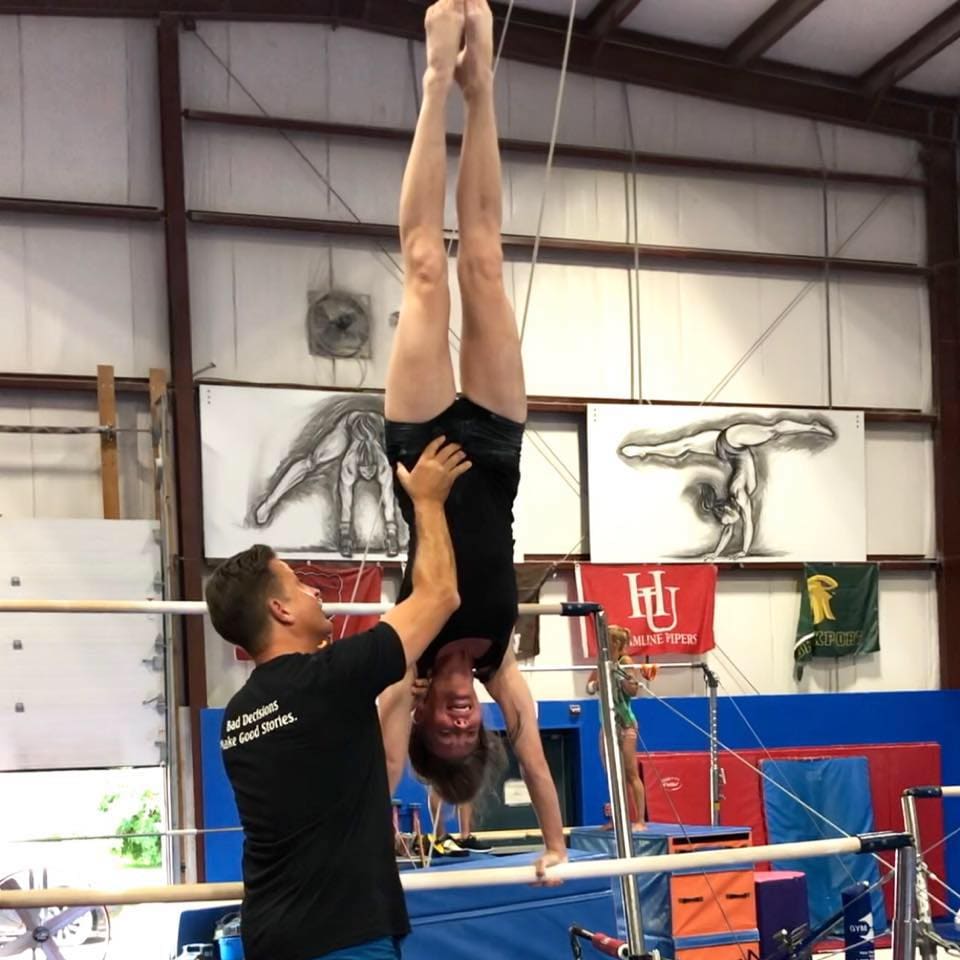 Conditioning isn't always the fun part of gymnastics, but the more you condition, the more fun the sport can become as you will learn and be capable of so much more.
Conditioning isn't always the fun part of gymnastics, but the more you condition, the more fun the sport can become as you will learn and be capable of so much more.physical preparation for success on the 4 women's artistic gymnastics events.
2018 NH WINTER ADULT CAMP CLINIC notes. Go here for info. on our next camp.
BY GINA PAULHUS, CPT
While gymnastics conditioning in general is important, there are specific aspects of conditioning and physical preparation that are particularly important for each of the 4 women's gymnastics events. By mastering these, you will save yourself much time and frustration when attempting to learn new skills or improve old ones. Also covered: warm-up and injury prevention.
warming up is non-negotiable
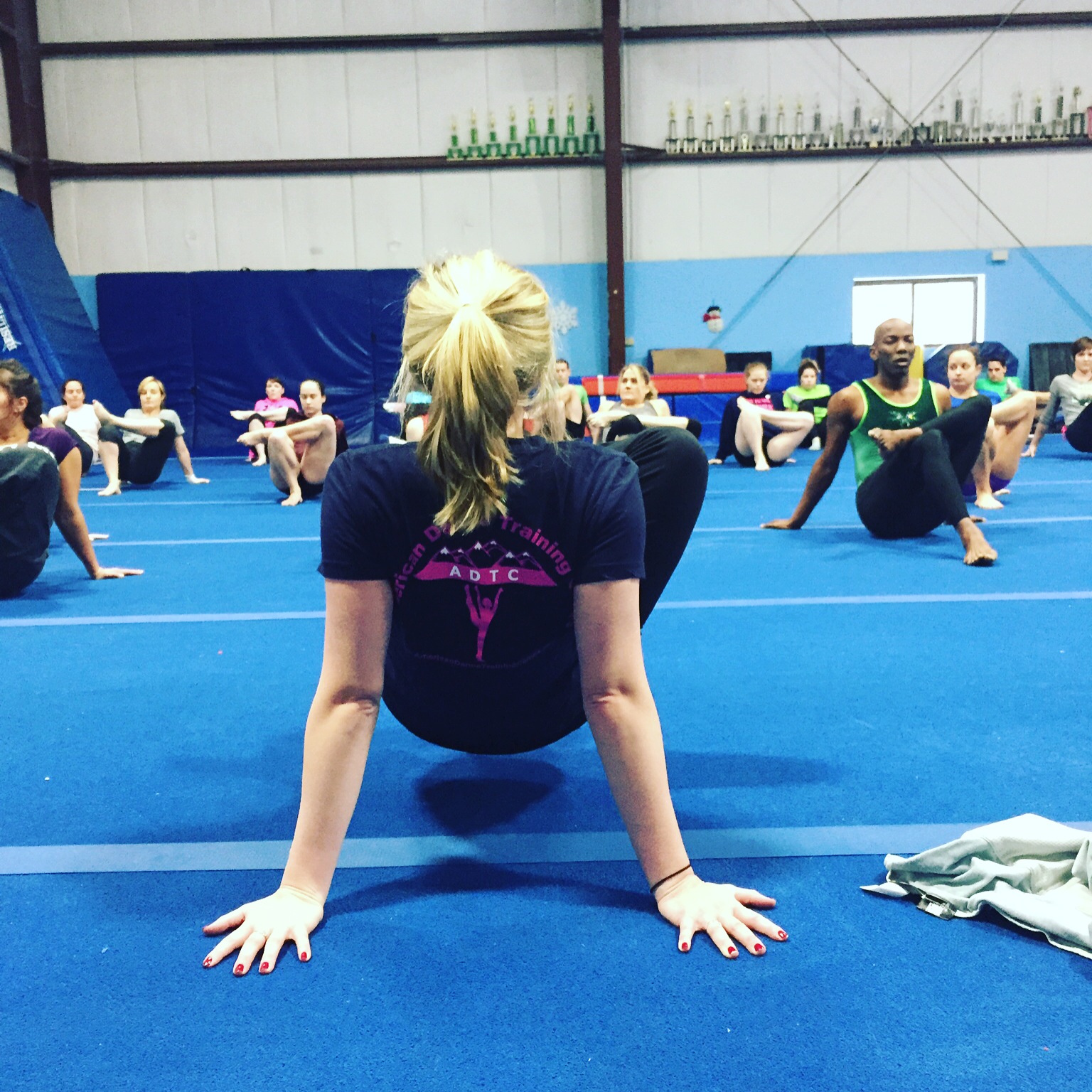 Adult gymnasts might need to spend a little extra time warming up, but that is the best way to make sure you keep your body safe.
Adult gymnasts might need to spend a little extra time warming up, but that is the best way to make sure you keep your body safe.Break a sweat. Make sure you spend at least 5 minutes getting your body moving and your blood pumping. Each day try to vary it so that your body doesn’t get used to the same old routine. Incorporate movements similar to gymnastics. For example: rather than plain old jogging, try skipping and doing chasses and high knees. Jumping rope and sprints are great things to incorporate. When conditioning for adult gymnasts, be sure you take the time to warm up thoroughly to protect your joints.
Active flexibility. Spend at least 5 minutes swinging your arms and legs and opening up your joint mobility. This also primes your nervous system to switch gears into quicker movements that you will need for gymnastics. Holding a position is fine, such as for splits, but keep it to 8 seconds or less. If you hold a stretch for much longer, you risk slowing your reflex speed and lowering your strength in the short term (for the next 2 hours or so) which will only increase your risk of injury before a training session. Longer stretching can go at the end of practice or later in the day.
Variety is key. There are so many aspects of gymnastics that you can’t possibly cover everything at once thoroughly in each warm-up. Therefore, it makes sense to change the focus of your warm-up from one day to the next. If you’ll mainly do beam and floor that session, focus on split positions and toe point. If you’ll mainly be on bars, focus on upper body mobility and core. Have lists you can work off so that you don’t have to think during your warm-up. It’s important to get your mind away from the stress of daily life and into ‘auto pilot’ before training.
This clinic was given at the Adult Gymnastics Camp held in Portsmouth NH.
vault
Running. Every great vault starts with a great run. Running is the input that goes into your vault, and it needs to be strong. Make sure you keep your core tight and engaged as you run. To strengthen core, try laying out panel mats. You have your shoulders on one panel and your thighs on another. Hold your body up lying on the 2 panel mats facing down, facing up, and facing to each side. Try a 30 second hold with flat hips in all positions. Try doing 4 mountain climbers to a full speed sprint down the vault runway facing away from the vault 4x before you actually vault. This will help you work speed and also get the kinks out before you actually vault.
Punching. Do 10 rebounding jumps on the board. Circle your arms with elbows bent. Focus on pointing through your toes. Try a hurdle and punch the board (from a few steps) and land behind the board. Make sure you use the same arm circle or position you’d use when you vault. If you’re advanced, try a single-leg hop on your hurdle leg 3x to immediate punch the board, land behind it. These can also be done before you vault or in between vaults.
Shapes/landings. Work the shapes and landings with other events. If you’re doing a tsuk, do backward rolls or standing tucks off a beam. If you’re doing a handspring twist, roll down a wedge mat using the same arm drop, or jump off a beam, twist and land. Handsprings can be done from a step in off a beam as well. You can do way more reps more quickly off a beam, so the benefits will come faster than if you only do it on vault. Use the same form (arm circle, block before handstand) as you would for a vault.
Tension. Work anti-rotation core exercises like a Palov Press with a Theraband (video below). Practice rebounding on your hands with your body held tight in a handstand—hands on the board (You’ll need a friend to help balance you). Work handstand pops on floor and up to a panel mat (try a half panel first).
bars
 If you only do one conditioning type in a practice make it bars conditioning! Bars is the hardest event for most adults to have enough strength for.
If you only do one conditioning type in a practice make it bars conditioning! Bars is the hardest event for most adults to have enough strength for.Hanging. Bars starts with working hanging, which helps with swinging when done correctly. Hang with your shoulders relaxed but your body form tight in all 3 grips for at least 30 seconds (low bar is OK if you need the floor support at first). Rope climb helps with hanging endurance. Challenge yourself to count the number of pulls (each hand movement is a pull). Build up to not using your legs. It’s easier to go down without legs than up, so work that for a while). All bar conditioning will be helpful (hanging leg lifts, stalder lifts, chin-ups, pullovers on high bar, stall bar leg lifts, casts in a row).
Keep Away from the Bar. As you’re doing basics or working strap bar, focus on how far away you can keep your center of mass away from the bar. There is a tendency to pull our body toward the bar so that we feel safer. The truth is that the farther we keep our mass away from the bar, assuming we have the strength to hold that position, the more swing we generate the easier bars is to do. As you get comfortable during easy skills, you’ll be able to do this with harder ones too. It’s tricky to keep body tight but shoulders relaxed, but you can train the muscle memory if you keep thinking about it for a little while.
Floor Bar. Hold your body in a push-up position or handstand with good body form - hands on the floor bar. Have your thumbs next to your fingers if that's how you plan on casting. Do conditioning on a floor bar (push-ups, presses, one armed handstands against a wall). Be precise with drills. Work a straddle up from jump, than from your knees. Work lowering slowly from the handstand with control. Work press leaning into a wedge, or a jump straddle up with feet facing the wall. See how long you can balance your handstand. Work pirouettes. You can do 10 pirouettes in one minute on a floor bar—that would never be possible on a real bar. Take advantage. It also won’t hurt your hands to do floor bar when they're sore.
Planches. The planche position (shoulders leaning over) is essential for both strength and helping with fear of leaning over the bar. Casting requires both. Work holding planches anywhere you can, and also moving in and out of a planche using a floor bar with feet on a yoga ball. Straddle leg position makes planche easier, and having a spotter can help you push the limit of how far you can lean. Never bend your arms or let your back arch - keep good form at all times.
Arch/hollow. Do these on the floor, and also hanging from a bar. Try holding the arch for 5 seconds and the hollow for 5 seconds. Do sets of 6 holds. Try moving fast between arch and hollow. These are going to help tap swings, flyaways and giants.
Straddle up. In addition to the floor bar work mentioned above, try adding ankle weights. This will make it easier when you actually go to cast for real. A good straddle up cast starts with a strong pike up. Getting your butt up over your head is going to be the hard part - the straddle up is easier. So prioritize that when you condition by taking the straddle part out. Do pike presses against a wall, and also pike drag-ups using a spotting block. Go to the side of a block, place your hands on it and ‘slide’ your feet up the block until your feet are standing on the mat. You can use a beam but it's a little harder to balance. You might need a spotter at first.
beam
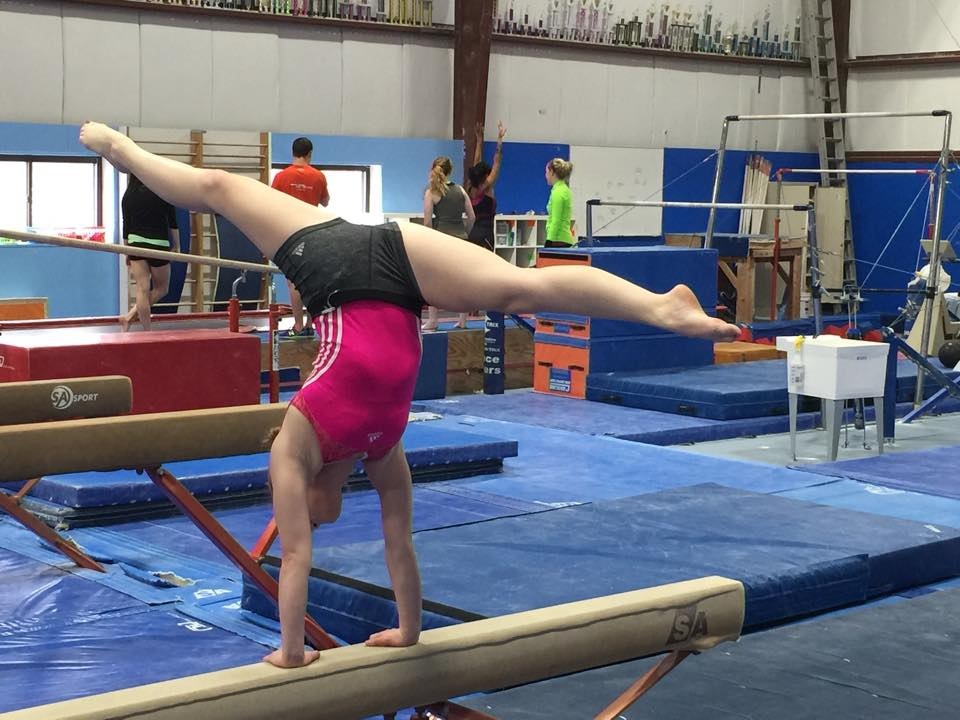 You can't spend enough time working out on beam, and that includes conditioning!
You can't spend enough time working out on beam, and that includes conditioning!Time on the beam. There is no substitute for getting comfortable with the beam by just being on it as much as possible. Stretch on the beam, do splits, do core. Try some simple standing exercises on the beam with your eyes closed. 30 seconds is a good length for these exercises. As your body fatigues, balance is the first to go, and especially when your vision can’t help you adjust. Working with eyes closes helps build air awareness and endurance.
Beam feet and hands. Just because you can do a skill on the floor doesn’t mean you can automatically do it on a beam. This is because you only have so much space to put your body parts! Work skills on a line with the proper feet and hands to fit on a beam. Try simple ballet positions on the beam. Do lots of handstands forward and sideways on the beam. Try holding a split handstand and open and close the split 5 times (do both sides). Decide how you will place your feet and hands for each skill and stick to it even when warming up or practicing on a line. Your brain and muscles need to memorize a plan. Even if you use a wider beam pad sometimes, enforce the same feet and hands that you’ll need on the real beam.
General balance. Challenge yourself with how long you can stand on one leg - with the leg bent, with the leg straight and also with your eyes closed. Try standing on something squishy (tumbletrak or a block of foam). Yoga practice is great for balance. Also, when you work new skills, a high beam with mats piled under will transfer more easily than a low beam, as your visual perspective is different from the higher surface. Do that whenever possible. It will help you get to the point of using the high beam with no mats more quickly.
Stretch on a line. Whenever you work splits or bridges, do them with as much of your body over the line as possible. This will help you stay centered to the beam during your skills. Bridges may require using a low beam and having just hands in beam position or just feet at first. Hold everything for at least 20 seconds. If you hold longer than 20 seconds, I suggest saving that until the end of practice.. Standing pike stretch on a beam both forwards and sideways is great also.
Up to a Panel. Any skill with flight can be done up to a panel to improve amplitude. Hands go on the floor on a line and feet on the panel (remember your beam feet). If you can do, say, a roundoff with your feet landing up higher than the surface of the beam, you will have time to ‘float’ down to your landing. This will make everything safer and way less scary.
Change beams often. Avoid hanging out on your ‘favorite’ beam all night. Do four skills or drills on one beam then move to the next. You’ll get extra cardio jumping around, and you’ll also grow to trust your own body more than the actual beam you’re on. Also, balance fatigues quickly, so by switching beams you give yourself a little break which increases safety. Bonus: face different sides of the gym when doing your skills. You want to be able to do the skill no matter what you see around you, especially if you compete!
floor
Basics lists. Have at least 4 basics lists you can follow that include things like step kicks, cartwheels and cartwheel step-ins, various types of rolls, leaps from just a stand, toe turn drills, etc. Get really good perfecting one list before switching to the next. These are all root skills of your big skills and getting good at them will really pay off. Focus on form, style and precision. As you perform your basics, pretend you're in the Olympics! It's that important. One list can focus on acro. Another can focus on dance.
Pace and acceleration. Make your leg conditioning similar to what you need to tumble and jump. Example: switch jump lunges are better than slow lunges. Roll back candlestick jump up to a 3 foot mat or so is great because it incorporates a layout shape, a deep knee bend (for those times when you crash) and a big jump. Rebounding across the floor straight, forward, backward, over a line and with shapes is great. Jumping off a high block to stick is great. All these things will strengthen your legs more specifically for gymnastics. Heel drives holding a vault table lying on your belly is wonderful as well. For an added bonus, squeeze a block of foam between your feet for leg tension. A kickball can be used in place of a block of foam as well. 12 reps is good for a lot of leg exercises.
Pushing strength. Aside from the leg strength we just covered, handstand push-ups, regular push-ups and handstand shoulder taps will pay dividends for your tumbling. Dips will strengthen pushing as well. If your arms are the weak link, your tumbling will die in the water. You might need to start with 6-8 reps and build up for the arm exercises. A spotter can be helpful too. Throw in some weighted calf raises or single leg calf raises off a stair to round out the other leg pushing strength like lunges and squats. Pushing strength is anything where you push your body away from something, like the floor.
Core connects it all. If your core leaks power and tightness, all the arm and leg strength in the world will not help you. Rockers, crunches, candlestick pulls, hamstring push-ups, glute/hip exercises like clamshells with a mini-band, planks, and mid-back exercises like I, T, Y series will all help. Core helps every event, but since floor is the basis for the other events I placed it here. If you are not familiar with core exercises, a session or two with a personal trainer can really pay off.
If you don't know where to find a trainer who knows gymnastics, contact me and I'll help you virtually!
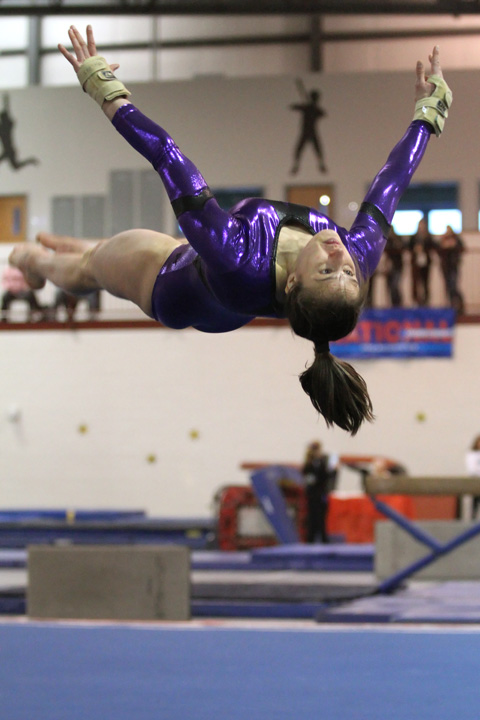 Conditioning will go a long way toward increasing your power in gymnastics.
Conditioning will go a long way toward increasing your power in gymnastics.odds and ends
injury prevention
Pull exercises. Since most of gymnastics involves pushing strength, you want to make sure you work the opposite action which is pulling exercises. The reason is that your body works like a series of pulleys. If your pulley system is out of whack, your body gets out of whack as well. This is bad. So things like chin-ups, leg curls, shin exercises, and forearm extensor strengtheners (wrist roller) are all important. Lower back is part pulling as well. Bicep curls and reverse crunches and glute bridges can all be considered pulls. It’s a good idea to include the same number of pulls as pushes as a rough rule of thumb for your conditioning.
Yoga/breathing work. These modalities cue your body to tone down the stress after a hard workout. They help bring your central nervous system back down to a comfortable state so that you can recover. Choose which methods you prefer and incorporate them into your week. A simple tip is to breathe in through your nose and out through your nose to calm your nervous system, whether during training or anytime. “When doing yoga, try to allow your body to relax a bit more and more which each full breath you take in and out. Even 2-3 minutes is better than nothing. You will really notice the difference in your recovery from training. Adult gymnasts in particular really benefit from the added mobility as a result of these modalities. Meditation can also fall into this category.
Cardio. This is useful to do on a day in between gymnastics. Cardio will help your endurance which helps you do more reps each practice. It also helps flush the lactic acid in your body that leads to soreness, and burns more calories than most gymnastics training which is good for general health and bodyfat control. If you have sore joints, perform lower impact cardio such as spin bike, elliptical or swimming. Intervals with sprints are very transferrable to gymnastics needs and improved fitness and explosiveness. Most gymnasts won't need more than a couple of days of cardio per week to stay fit.
Weight training/hard conditioning. If you want to really kill yourself with strength work, and you also practice three or more days a week, you might need to do it on the same day as practice (cat be before/after, or at a different time of day) The reason is, you generally need 48 hours after working a body part to allow it to recover, and since gymnastics usually put all of the body through a good amount of strain/impact, you don’t want to strength train the next day if you can help it, especially if you’re really pushing yourself and especially if you’re not a kid anymore. The good news is that gymnastics itself will get you stronger too, so you shouldn’t need more than a half hour or so to add targeted strength for your whole body. Give yourself a week off here and there to allow your body to thoroughly recover from the work. If you don't have time to strength train often, be sure to really push yourself when you do, so that all the days off you will have will go to good use with recovery. If you strength train often, you probably will have to peel back the effort a bit to more like 80% so that you don't burn yourself out. The less often you work out - the higher the intensity you can afford.
need guidance with your conditioning plan?
No worries, I've got you!
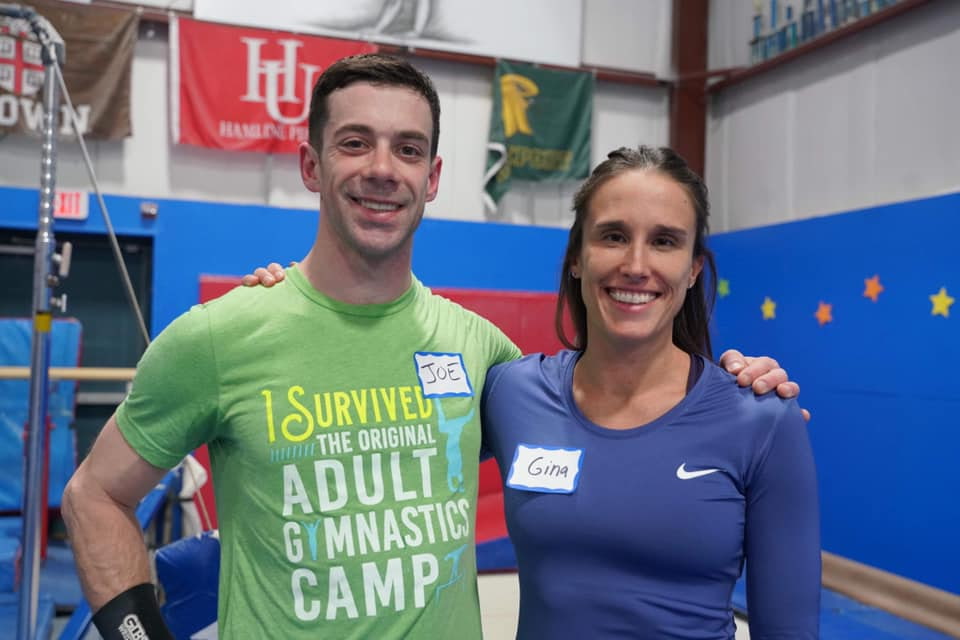
personal training sessions catered to adult gymnast conditioning
You can fill out the form below to request a price quote on a one-on-one session. You can also see our online personal training options that come as custom packages.
- Home
- Training Tips
- Adult Gymnast Conditioning
Disclaimer: Adult gymnasts and coaches give advice and suggestions on this page. By reading and implementing the information, you assume all liability for injury. The advice given is for educational purposes only. Please check with your in-person coach and ensure that you have the proper pit, mats and/or spot available before trying any suggestions. If you don't agree to these terms, do not attempt anything that you see on this page.
Recent Articles
-
The Original Adult Gymnastics Camp 2025 Review
Aug 01, 25 11:06 AM
Come inside The Original 2025 Adult Gymnastics Camp Review and see what it's like to be there. Join us in the fun next summer. -
USAG has no upper age limit in gymnastics
Dec 12, 24 08:56 AM
USAG has no upper age limit in gymnastics as long as the athlete is a member in good standing and has a coach. -
The Original Adult Gymnastics Camp: 2024 Edition
Jul 31, 24 10:07 AM
Come inside The Original 2024 Adult Gymnastics Camp and see what all the talk is about!



